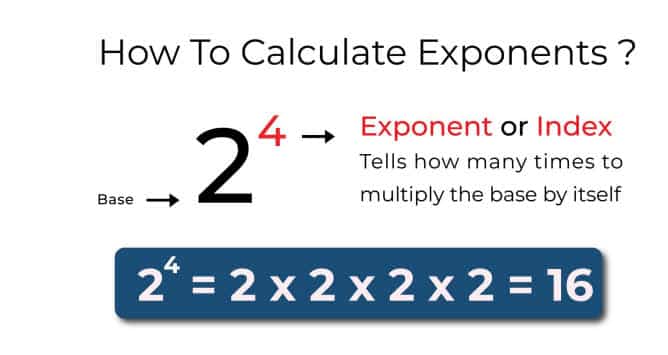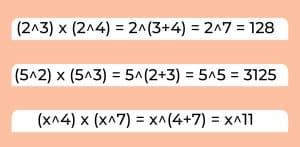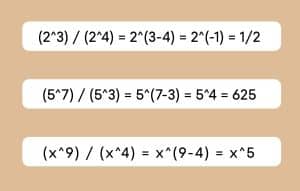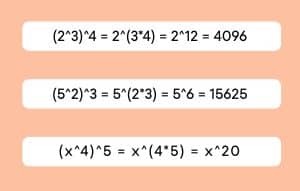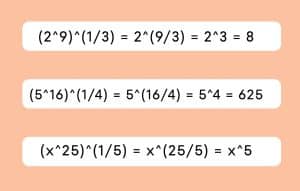Laws of Exponents
Grade 6 Math Worksheets
An exponent refers to the number of times a number, called the base, is multiplied by itself.
Power is an expression that represents the multiplication of a number, called the base, by itself a certain number of times. The number of times the base is multiplied by itself is called the exponent.
In this article, we will cover:
- The Product of Powers with the Same Base
- The Quotient of Powers with the Same Base
- A Power to a Power
- The nth Root of a Power
- Zero Power
- FAQs
Laws of Exponents - Grade 6 Math Worksheet PDF
This is a free printable / downloadable PDF worksheet with practice problems and answers. You can also work on it online.
|
|
Untimed |
|
Sign up with your email ID to access this free worksheet.
"We really love eTutorWorld!"
"We really love etutorworld!. Anand S and Pooja are excellent math teachers and are quick to respond with requests to tutor on any math topic!" - Kieran Y (via TrustSpot.io)
"My daughter gets distracted easily"
"My daughter gets distracted very easily and Ms. Medini and other teachers were patient with her and redirected her back to the courses.
With the help of Etutorworld, my daughter has been now selected in the Gifted and Talented Program for the school district"
- Nivea Sharma (via TrustSpot.io)
For example, in the expression 8^3, the base is 8 and the exponent is 3. This can be read as “8 to the power of 3” or “8 cubed.” The exponent tells us how many times the base is used as a factor in a multiplication problem. In this case, 8 is multiplied by itself 3 times, so the result is 8 x 8 x 8 = 512.
An exponent is a small number written above and to the right of the base. It is used to indicate the number of times the base is used as a factor in a multiplication problem. In example 8^3, the exponent 3 indicates that the base 8 is multiplied by itself 3 times, resulting in a value of 512.
So, while power is an expression that represents the multiplication of a number by itself a certain number of times, the exponent is the number of times the base is multiplied by itself.
Laws of Exponents
There are four main laws of exponents:
1. The Product of Powers with the Same Base
The Product of Powers with the Same Base states that if you have two or more powers with the same base, you can find their product by adding the exponents. This means that if you have two numbers that are both raised to a power, and the base of those two numbers is the same, you can multiply them by adding the exponents
a^m x a^n = a^(m+n) where m and n are real numbers.
Here are some examples to illustrate this law:
In these examples, we have two powers with the same base (2, 5, and x). To find the product of these powers, we add the exponents (3+4, 2+3, and 4+7). The result is the base raised to the sum of the exponents.
It’s important to note that this law only applies when the base of the powers is the same. If the bases are different, you cannot use this law to find the product.
2. The Quotient of Powers with the Same Base
The Quotient of Powers with the Same Base states that if you have two powers with the same base and you want to divide them, you can find the quotient by subtracting the exponents. This means that if you have two numbers that are both raised to a power, and the base of those two numbers is the same, you can divide them by subtracting the exponents.
a^m / a^n = a^(m – n) where m and n are integers and a is any non-zero term.
Here are some examples to illustrate this law:
In these examples, we have two powers with the same base (2, 5, and x). To find the quotient of these powers, we subtract the exponents (3-4, 7-3, and 9-4). The result is the base raised to the difference of the exponents.
It’s important to note that this law only applies when the base of the powers is the same. If the bases are different, you cannot use this law to find the quotient.
3. A Power to a Power
A Power to a Power states that if you have a power raised to another power, you can find the result by multiplying the exponents. This means that if you have a number that is raised to a power, and that power is itself raised to another power, you can find the result by multiplying the two exponents.
(a^m)^n = a^(m*n) where a is any non-zero term and m and n are integers.
Here are some examples to illustrate this law:
In these examples, we have a power that is raised to another power (2^3, 5^2, and x^4). To find the result, we multiply the exponents (3*4, 2*3, and 4*5). The result is the base raised to the product of the exponents.
It’s important to note that this law only applies when the base of the powers is the same. If the bases are different, you cannot use this law to find the result.
“There have been times when we booked them last minute, but the teachers have been extremely well-prepared and the help desk at etutorworld is very prompt.
Our kid is doing much better with a higher score.”
6th Grade Tutoring
eTutorWorld offers Personalized Online Tutoring for Math, Science, English, and Standardised Tests.
Our Tutoring Packs start at just under $22.49 per hour, and come with a moneyback guarantee.
Schedule a FREE Trial Session, and experience quality tutoring for yourself. (No credit card required.)
4. The nth Root of a Power
The nth Root of a Power states that if you have a power and you want to find its nth root, you can do so by dividing the exponent by n. This means that if you have a number that is raised to a power, and you want to find the root of that power, you can do so by dividing the exponent by the root you are looking for.
Here are some examples to illustrate this law:
In these examples, we have a power that we want to find the root of (2^9, 5^16, and x^25). To find the root, we divide the exponent by the root we are looking for (9/3, 16/4, and 25/5). The result is the base raised to the quotient of the exponent and the root.
It’s important to note that this law only applies when the base of the power is the same. If the bases are different, you cannot use this law to find the root.
5. Zero power
According to this rule, when the power of any integer is zero, then its value equals 1.
For example- 4^0 = 1.
Do You Stack Up Against the Best?
If you have 30 minutes, try our free diagnostics test and assess your skills.
Order of Operations FAQS
What is the difference between power and exponent?
In mathematics, the term “power” and “exponent” are related but not exactly the same.
Power is an expression that represents the multiplication of a number, called the base, by itself a certain number of times. An exponent is a small number written above and to the right of the base. It is used to indicate the number of times the base is used as a factor in a multiplication problem. So, while power is an expression that represents the multiplication of a number by itself a certain number of times, the exponent is the number of times the base is multiplied by itself.
What is scientific notation?
Scientific notation is a way of expressing very large or very small numbers in a more convenient form. In scientific notation, a number is written as a base times 10 to some power. For example, the number 200,000 can be written as 2 x 10^5 in scientific notation. The base is 2, and the exponent (5) tells us that the base is multiplied by itself 5 times and then multiplied by 10.
How do you simplify expressions with exponents?
To simplify an expression with exponents, you can use the laws of exponents. These laws include the
Product of Powers with the Same Base, the Quotient of Powers with the Same Base, A Power to a Power, and the nth Root of a Power. By using these laws, you can simplify expressions by combining like terms (terms with the same base) and performing any necessary calculations.
What are some real-world applications of exponents?
Exponents have many real-world applications in fields such as science, engineering, and finance. In science and engineering, exponents are used to represent very large or very small numbers, such as the size of the universe or the size of an atom. In finance, exponents are used to represent exponential growth or decay, such as the growth of an investment or the decay of a radioactive substance.

Gloria Mathew writes on math topics for K-12. A trained writer and communicator, she makes math accessible and understandable to students at all levels. Her ability to explain complex math concepts with easy to understand examples helps students master math. LinkedIn
Affordable Tutoring Now Starts at Just $22.49
eTutorWorld offers affordable one-on-one live tutoring over the web for Grades K-12. We are also a leading provider of Test Prep help for Standardized Tests (SCAT, CogAT, MAP, SSAT, SAT, ACT, ISEE, and AP).
What makes eTutorWorld stand apart are: flexibility in lesson scheduling, quality of hand-picked tutors, assignment of tutors based on academic counseling and diagnostic tests of each student, and our 100% money-back guarantee.
Whether you have never tried personalized online tutoring before or are looking for better tutors and flexibility at an affordable price point, schedule a FREE TRIAL Session with us today.
*There is no purchase obligation or credit card requirement
Grade 6 Science Worksheets
- Inquiry process
- Nature of Science
- Scientific Inquiry
- Inquiry, Analysis and Problem Solving
- Ethical Practices
- Science and Society
- Biotic and Abiotic Factors
- Impact of Organisms
- Adaptation
- Spheres of Earth
- Natural Resources
- Environmental Issues
- Conservation of Earth
- Understanding Technology
- Abilities To Do Technological Design
- Structure of Earth
- Solar System
- Rocks and Fossils
- Earth Systems
- Plate Tectonics
- Evolution
- Magnetic Field of Earth
- Geologic Time
- Materials and Processes That Shape a Planet
- Astronomy
- Ecology
- Energy
- Kinetic and Potential Energy
- Energy Transfer
- Matter and its Structure
- States of Matter
- Physical and Chemical Changes
- Force and Motion
- Electricity and Magnetism
- Wave Interactions
- Sound
- Light
- Introduction to Life Science
- The Origin & History of Life On Earth
- Plant and Animal Cells
- Parts of a Cell
- The Cell Cycle
- How Living Organisms Get Energy
- Classification of Organisms
- How Plants Grow & Reproduce
- The Human Respiratory System
- The Human Cardiovascular System
- The Human Digestive System
- The Human Endocrine Systems
- The Human Nervous System
- The Human Muscular System
- The Human Skeletal System
IN THE NEWS

Our mission is to provide high quality online tutoring services, using state of the art Internet technology, to school students worldwide.
Online test prep and practice
SCAT
SSAT
ISEE
PSAT
SAT
ACT
AP Exam
Science Tutoring
Physics Tutoring
Chemistry Tutoring
Biology Tutoring
Math Tutoring
Pre-Algebra Tutoring
Algebra Tutoring
Pre Calculus Tutoring
Calculus Tutoring
Geometry Tutoring
Trigonometry Tutoring
Statistics Tutoring
Quick links
Free Worksheets
Fact sheet
Sales Partner Opportunities
Parents
Passive Fundraising
Virtual Fundraising
Our Expert Tutors
Safe and Secure Tutoring
Interactive Online Tutoring
After School Tutoring
Elementary School Tutoring
Middle School Tutoring
High School Tutoring
Home Work Help
Math Tutors New York City
Press
©2022 eTutorWorld Terms of use Privacy Policy Site by Little Red Bird
©2022 eTutorWorld
Terms of use
Privacy Policy
Site by Little Red Bird


